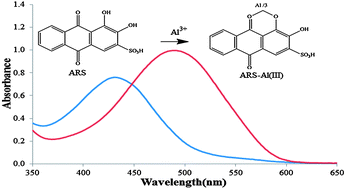Quantitative determination of Al(iii) ion by using Alizarin Red S including its microspheres optical sensing material
Abstract
A facile

* Corresponding authors
a
Industrial Chemistry Programme, Faculty of Industrial Sciences & Technology, Universiti Malaysia Pahang, Lebuhraya Tun Razak, 26300 Gambang, Kuantan, Pahang, Malaysia
E-mail:
babybabeoo@gmail.com
Fax: +60 09 5492 766
Tel: +60 09 5492 742
b
School of Chemical Sciences & Food Technology, Faculty of Science & Technology, Universiti Kebangsaan Malaysia, 43600 Bangi, Selangor, Malaysia
E-mail:
leeyookheng@yahoo.co.uk
Fax: +60 03 8921 3356
Tel: +60 03 8921 5410
A facile

 Please wait while we load your content...
Something went wrong. Try again?
Please wait while we load your content...
Something went wrong. Try again?
S. M. Supian, T. L. Ling, L. Y. Heng and K. F. Chong, Anal. Methods, 2013, 5, 2602 DOI: 10.1039/C3AY40238J
To request permission to reproduce material from this article, please go to the Copyright Clearance Center request page.
If you are an author contributing to an RSC publication, you do not need to request permission provided correct acknowledgement is given.
If you are the author of this article, you do not need to request permission to reproduce figures and diagrams provided correct acknowledgement is given. If you want to reproduce the whole article in a third-party publication (excluding your thesis/dissertation for which permission is not required) please go to the Copyright Clearance Center request page.
Read more about how to correctly acknowledge RSC content.
 Fetching data from CrossRef.
Fetching data from CrossRef.
This may take some time to load.
Loading related content
